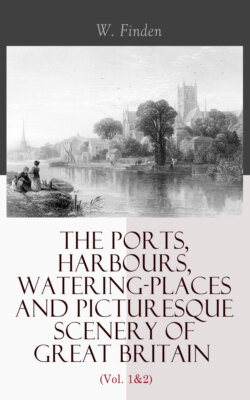Читать книгу The Ports, Harbours, Watering-places and Picturesque Scenery of Great Britain (Vol. 1&2) - W. Finden - Страница 18
На сайте Литреса книга снята с продажи.
ROBIN HOOD'S BAY.
ОглавлениеTable of Contents
The above is the name of a fine bay on the Yorkshire coast, between Whitby and Scarborough, and also of the fishing village, situated towards its northern extremity. In the view, which is taken from the north, several of the houses are seen standing upon the very edge of the cliff. The promontory to the left is called Ravenhill, and forms the south-eastern extremity of the bay. From an inscription dug up at Ravenhill in 1774, it appears that there had formerly been a Roman camp there.
The ancient name of the bay was Fyling, and from what reason or at what period it first received the name of Robin Hood's Bay is uncertain. That it ever was the resort of the famed outlaw of that name is extremely questionable; although two or three tumuli on the moor, about two miles to the southward of the village, are said to be the butts, in shooting at which he exercised his men in archery. Near Whitby Lathes, about five miles to the north-west of Robin Hood's Bay, are two upright stones, which are said to mark the spots where the arrows of the bold robber of Sherwood Forest, and his man Little John, fell, when, in a trial of strength, they discharged them from the top of Whitby Abbey in the presence of the abbot. As the distance from these stones to the abbey is rather more than a mile and a half, it is evident that a long bow must have been drawn by some one, if not by Robin Hood. It has been supposed that the place was originally called Robin Wood's Bay, from a fisherman of that name, who formerly resided there; but this conjecture rests on no better ground than the fact of two or three fishermen of the name of Wood having lived there in modern times. A family of fishermen of the name of Wood, with whom "Zebedee" appears to have been a favourite "fore-name," have resided at Runswick, a fishing village, about seven miles northward of Whitby, for several generations.
Leland, in his Itinerary, written about three hundred years ago, calls the village by its present name, Robin Hood's Bay, and describes it as "a fisher townlet of twenty boats." It is still, as in his time, almost entirely inhabited by fishermen. The houses forming the principal street are built on each side of a steep road, leading down to the shore; while others, as may be seen in the view, are built upon the very extremity of the cliff. The approach to the village is by a steep descent, which is extremely inconvenient for carriages. It is about fourteen miles north-west of Scarborough, and seven south-east of Whitby; and the population is about a thousand.
Robin Hood's Bay, Filey, Runswick, and Staithes, are the principal fishing villages on the Yorkshire coast. Filey is about eight miles south of Scarborough; Runswick, as has been previously observed, is about seven miles northward of Whitby; and Staithes is about three miles northward of Runswick. At each of those places the fishery is carried on both by cobles and by five-man boats. At most of the other fishing stations on the Yorkshire coast cobles only are employed. A description of the last named species will be found in our notice of Bambrough from the South-east; and of the five-man boats, we propose to say a few words on the present occasion.
The vessels now called five-man boats are about forty-six feet long, sixteen feet eight inches broad, and six feet three inches deep. They are clinker-built, sharp at the bows, and have a deck with a large hatchway in midships, and a cabin towards the stern for the men. They have three masts, on each of which they carry a lug sail. Their other sails are a jib, and, in fine weather, a top-sail set on a shifting topmast, above the main-mast. As the sails are all tanned, a five-man boat forms a picturesque object at sea, more especially when viewed in contrast with a square-rigged vessel with white sails. The crew of each five-man boat consists of seven persons, five of whom, called shares-men have equal shares of the proceeds of the voyage, or the season, after the boat's share is paid. The sixth person is often a young man who receives half a share, and is a kind of apprentice to the captain or owner of the boat. The seventh is generally hired at a certain sum per week, and not sharing in the profits of the fishery.
To each five-man boat there are two cobles, which in proceeding to the fishing ground are generally hauled up on the deck. On arriving at the place where it is intended to fish, the boat is anchored, and the cobles being launched, three men proceed in each to shoot their lines, while one remains on board. The lines used for this more distant fishery are called haavres. They are about the same length as those used in the coble fishery nearer the shore, though thicker, and having the hooks placed at greater intervals. As the six men who fish have each two sets of lines, they are thus enabled to shoot one set immediately after they have hauled the other. In the five-man-boat fishery the hooks are always baited at sea.
HARTLEPOOL.
